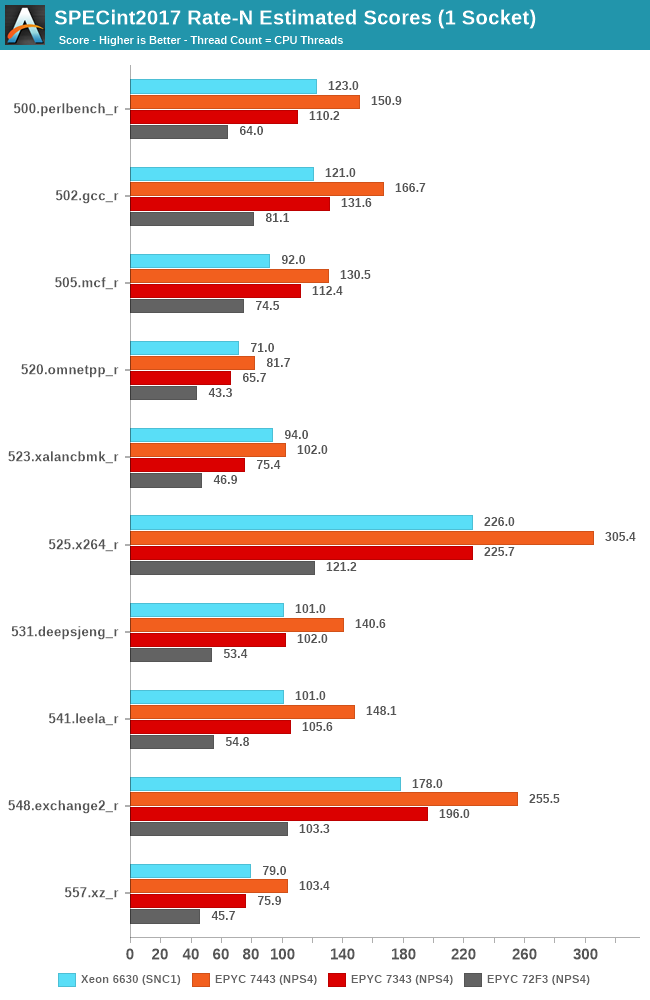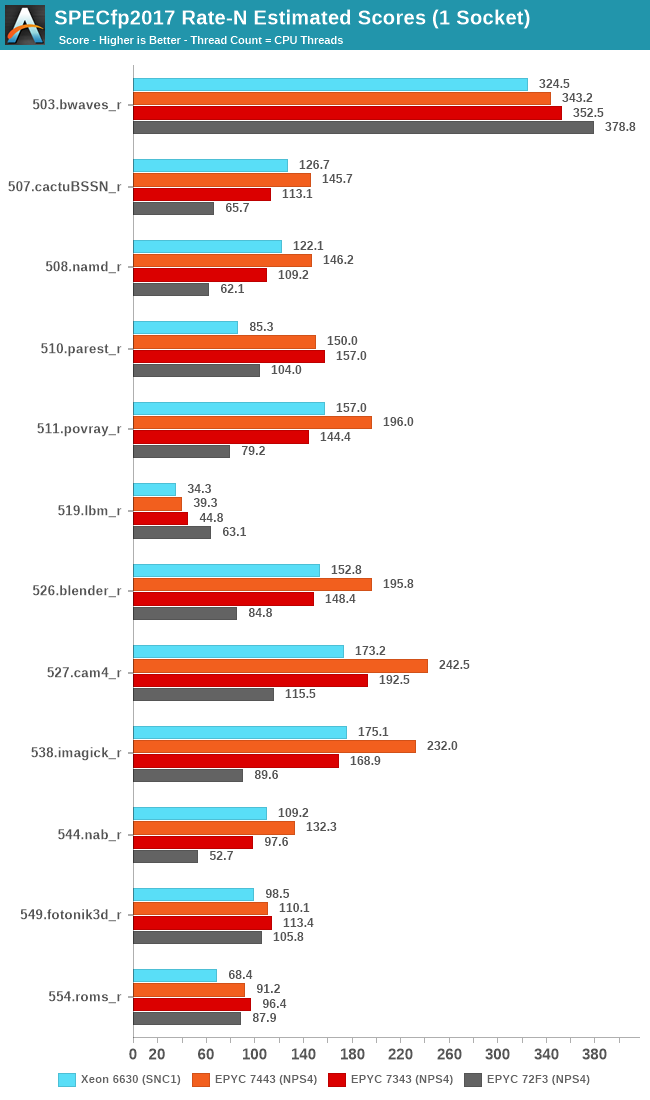AMD EPYC Milan Review Part 2: Testing 8 to 64 Cores in a Production Platform
by Andrei Frumusanu on June 25, 2021 9:30 AM ESTSPEC - Multi-Threaded Performance - Subscores
Picking up from the power efficiency discussion, let’s dive directly into the multi-threaded SPEC results. As usual, because these are not officially submitted scores to SPEC, we’re labelling the results as “estimates” as per the SPEC rules and license.
We compile the binaries with GCC 10.2 on their respective platforms, with simple -Ofast optimisation flags and relevant architecture and machine tuning flags (-march/-mtune=Neoverse-n1 ; -march/-mtune=skylake-avx512 ; -march/-mtune=znver2 (for Zen3 as well due to GCC 10.2 not having znver3).
I’ll be going over two chart comparisons, first of all, with the respective flagship parts, consisting of the new EPYC 7763 numbers, pitted against Intel’s 40-core Xeon Ice Lake SP and Ampere’s Altra Q80-33, along with the figures we have on AMD’s EPYC 7742. It’s to be noted that this latter is a 225W part, compared to the 280W 7763.

In SPECint2017, the EPYC 7763 extends its lead over Intel’s current best CPU, improving the numbers beyond what we had originally published in our April review. While AMD also further narrows the gap to Ampere’s 80-core Altra SKU, there are still many core-bound workloads that still notably favour the Neoverse N1 part given its 25% advantage in core count.

Also in SPECint2017, but this time focusing on the mid-tier SKUs, the main comparison points that are interesting here is the new 24-core EPYC 7443 and 16-core EPYC 7343 against the new 28-core Xeon 6330. What’s shocking here, is that Intel’s new Ice Lake SP server chip has troubles not only competing against AMD’s 24-core chip, but actually even struggles to differentiate itself from AMD’s 16-core chip, which is quite shocking.
The 72F3 8-core part is interesting, but generally we have troubles to competitively place such a SKU given that we don’t have a comparable part from the competition to pit against it.

For the high-end SKUs, we again see the 7763 increase its performance positioning compared to what we had review a few months ago, although with fewer large performance boost outliers, due o the memory-heavy nature of the floating-point test suite.

In the low-end SKUs, we see a similar story as in the integer suite, where AMD’s 16-core 7343 battles it out against Intel’s 28-core Xeon, while the 24-core unit is comfortable a good margin ahead of the competition.
The 72F3 showcases some interesting score here – because there’s more workloads that are fundamentally memory bound; the actual core count deficit of this SKU doesn’t really hamper its performance compared to its siblings. If anything, the lower core count actually has some positive side-effects as it results in less cache and DRAM contention, resulting in less overhead and actually higher performance than the higher core count parts. Theoretically you could mimic this with the higher core count parts by simply running fewer workload instances and threads, but if a system deployment would be running workloads that are more typical of such performance characteristics, the low-core count 72F3 could make sense.










58 Comments
View All Comments
DannyH246 - Thursday, July 1, 2021 - link
lol - no need to be subtle about it. www.IntelTech.com has been doing this for years.Qasar - Thursday, July 1, 2021 - link
hilarious, go back to wccftech then dannywhatthe123 - Friday, June 25, 2021 - link
good god man, the review quite literally posts hard numbers of epyc simply thrashing xeon in performance even on a per core basis, and you think they're worried that intel will retaliate against them if they don't say something nice about one corner of a segment of performance?what is it about technology that attracts cultists?
Threska - Saturday, June 26, 2021 - link
There's a reason the PCMasterRace forum exists.msroadkill612 - Sunday, June 27, 2021 - link
"Cultists" - I like it :)So true, & on many levels. I see strangely neurotic behaviour from such an allegedly smart & rational demographic.
As a group, they are prone to be great at rattling off streams of presumably accurate numbers and jargon, but arrive at childishly naive conclusions, & ask the wrong questions based plain wrong premises.
devione - Sunday, June 27, 2021 - link
Jesus Christ man. Grow some fucking balls. If you're going to call out Anandtech for being biased at least be straightforward and frank. No need to write an essay trying to couch and justify and be obtuse about itMakste - Monday, July 5, 2021 - link
LmaoOxford Guy - Friday, June 25, 2021 - link
What are the RAM timings? I don’t see that information in the charts.Andrei Frumusanu - Saturday, June 26, 2021 - link
These are standardised PC4-3200AA-RB2-12 sticks, running at JEDEC timings.https://www.micron.com/products/dram-modules/rdimm...
Oxford Guy - Monday, June 28, 2021 - link
Thank you. And the other systems tested?